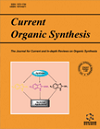- Home
- A-Z Publications
- Current Organic Synthesis
- Previous Issues
- Volume 17, Issue 6, 2020
Current Organic Synthesis - Volume 17, Issue 6, 2020
Volume 17, Issue 6, 2020
-
-
Halogenated Flavones and Isoflavones: A State-of-Art on their Synthesis
More LessAuthors: Ricardo Santos, Diana Pinto, Clara Magalhães and Artur SilvaBackground: Flavonoid is a family of compounds present in the everyday consumption plants and fruits, contributing to a balanced diet and beneficial health effects. Being a scaffold for new drugs and presenting a wide range of applicability in the treatment of illnesses give them also an impact in medicine. Among the several types of flavonoids, flavone and isoflavone derivatives can be highlighted due to their prevalenc Read More
-
-
-
Green Solvent: Green Shadow on Chemical Synthesis
More LessThe natural beauty and purity of our planet has been contaminated deeply due to human selfish activities such as pollution, improper waste management, and various industrial and commercial discharges of untreated toxic by-products into the lap of nature. The collective impact of these hazardous suspensions into the natural habitat is very deadly. Challenges due to human activity on the environment have become Read More
-
-
-
Novel Biomass Derived from Grape Pomace Waste as an Efficient Nanocatalyst for the Synthesis of Dibenzoxanthene, Tetraketone, bis(indolyl)alkane and Chromene Derivatives and their Antimicrobial Evaluation
More LessAuthors: Fatemeh Ghorbani, Seied A. Pourmousavi and Hamzeh KiyaniBackground: Sulfonated carbon-based solid acids (CBSAs) have been reported as an efficient solid acid catalyst for many acid-catalyzed reactions. Furthermore, the use of carbon obtained from biomass waste has been explored and these materials showed a higher catalytic performance and higher stability compared to other solid acids. Objective: Novel biomass carbon-based solid acids nanoparticles with high catalytic activit Read More
-
-
-
L-Cysteine Catalyzed Environmentally Benign One-pot Multicomponent Approach Towards the Synthesis of Dihydropyrano[2,3-c]pyrazole Derivatives
More LessBackground: The pyrano[2,3-c]pyrazole derivatives are important building blocks of many biologically active compounds owing to their diverse biological potential for example, anti-inflammatory, anticancer, anti-microbial and anti-oxidant properties. Objective: Keeping in mind the wide range of applications of pyrano[2,3-c]pyrazoles, herein we intended to develop a novel synthetic methodology for dihydropyranopyrazol Read More
-
-
-
s-Proline Covalented Silicapropyl Modified Magnetic Nanoparticles: Synthesis, Characterization, Biological and Catalytic Activity for the Synthesis of thiazolidin-4-ones
More LessBackground: Thiazolidinoneones are important pharmaceutical compounds because of their biological activities. Several methods for the synthesis of 4-thiazolidinones are widely reported in the literature. The main synthetic routes to synthesize 1,3-thiazolidin-4-ones involve three components reaction between amine, a carbonyl compound and thioglycolic acid. Objective: s-Proline covalented silicapropyl modified magnetic nan Read More
-
-
-
One-pot Multicomponent Synthesis of pyrrolo[1,2-d][1,4]benzoxazines and pyrrolo[1, 2-a]pyrazines in Water Catalyzed by Fe3O4@SiO2@L-Arginine-SA Magnetic Nanoparticles
More LessAuthors: Hedieh Rostami and Lotfi ShiriAims: Synthesis of pyrrolo[1,2-d][1,4]benzoxazines and pyrrolo[1,2-a]pyrazines using magnetic nanoparticles. Background: One-pot, three component reaction for the synthesis of pyrrolo[1,2-d][1,4]benzoxazines and pyrrolo[1,2-a]pyrazines is reported. For the synthesis of pyrrolo[1,2-d][1,4]benzoxazines use of 2- aminophenols, dialkylacetylenedicarboxylates and β -nitrostyrene derivatives and Pyrrolo[1,2-a]pyrazines sy Read More
-
-
-
Highly Efficient Ultrasound Promoted Synthesis of 2-phenylquinoxaline in Glycerol-Water
More LessAuthors: Mujahed Shaikh, Devendra Wagare, Ashvini Sonone and Ayesha DurraniIntroduction: Quinoxalines show diversified applications in the field of medicinal chemistry. Materials and Methods: Therefore, we have designed a highly efficient, environmentally benign and one-pot protocol for the synthesis of 2-phenylquinoxaline from the reaction of Acetophenone, N-bromosuccinimide and 1,2-phenylenediamine under ultrasound irradiation in glycerol-water. Results and Discussion: We observed that, a Read More
-
-
-
Synthesis and Characterization of New Zinc Phthalocyanine - Dodecenyl Succinic Anhydride Benzoic Groups
More LessBackground: The phthalocyanines a series of compounds involves four iso-indole units linked by aza nitrogen atoms bonded with metal atoms that are normally located in the center a phthalocyanines ring. Some of the central metal-phthalocyanines can be excited by ultraviolet light and emit a fluorescence in far-red region. Objective: To synthesize a derivative of phthalocyanines namely 4,4',4' '-tri-(dodecenyl succinic anhydride Read More
-
Volumes & issues
-
Volume 22 (2025)
-
Volume 21 (2024)
-
Volume 20 (2023)
-
Volume 19 (2022)
-
Volume 18 (2021)
-
Volume 17 (2020)
-
Volume 16 (2019)
-
Volume 15 (2018)
-
Volume 14 (2017)
-
Volume 13 (2016)
-
Volume 12 (2015)
-
Volume 11 (2014)
-
Volume 10 (2013)
-
Volume 9 (2012)
-
Volume 8 (2011)
-
Volume 7 (2010)
-
Volume 6 (2009)
-
Volume 5 (2008)
-
Volume 4 (2007)
-
Volume 3 (2006)
-
Volume 2 (2005)
-
Volume 1 (2004)
Most Read This Month
Article
content/journals/cos
Journal
10
5
false
en


